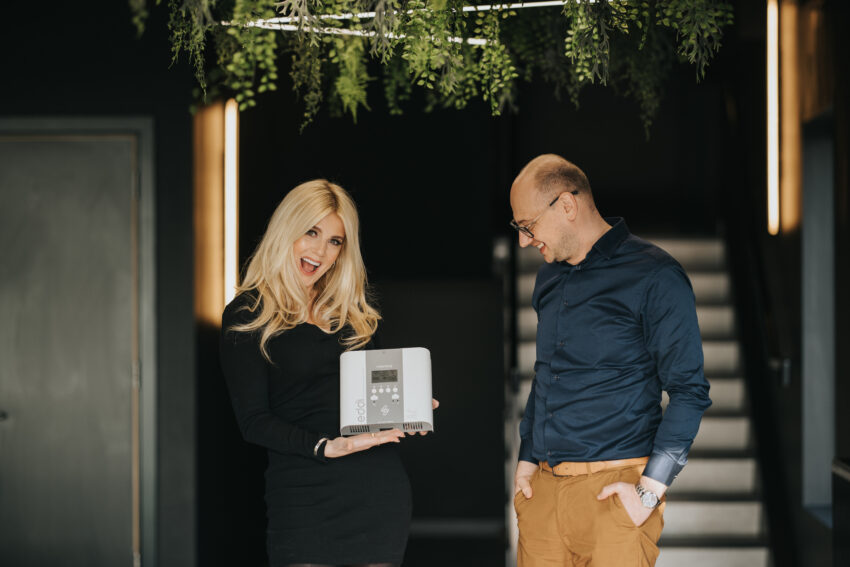Bright spark: The meteoric rise of myenergi
Recently ranked as the ninth fastest growing company in the UK, myenergi is spearheading the nation’s transition to sustainable living. With a range of EV charging and renewable energy products available, the company continues to grow at an impressive rate. But what is next for myenergi?
In an exclusive interview with EV Powered, Tom Callow, Head of External Affairs for myenergi, shares his thoughts on the long-term goal of the company and the importance of solar in the UK’s green transition.

Hi Tom. We last spoke to you when you were at Chargemaster. You’ve been at myenergi for almost a year now. How has it been so far? What attracted you to the company?
Two things really attracted me. Firstly, it’s opportunity to work in a broader product set. myenergi is a fantastic business that isn’t just an EV charging provider. Our first product was the eddi, the energy diverter, and we’ve got our Libby now home battery. We’ve got this amazing product range where we can really start to connect the home energy ecosystem and that for me is a massive draw. Being able to step outside just EV charging and think more broadly about how we’re going to decarbonise the rest of our lives.
Secondly, it was the brand. myenergi is a brand I’d admired for years, I’d really admired what Jordan Brompton had done with building the brand and maintaining it in this very honest, transparent and very credible way. There’s no better business than one that’s been formed by this genius engineer in Lee Sutton, our CEO, and a genius marketeer in Jordan, who’s our CMO. Those two as co-founders was just an unbeatable combination. In my time in personal communications and PR, trying to help people tell their story, I’ve seen so many businesses that have a fantastic engineering side but they have no ability to communicate it, and it’s so sad because they’ve got a great product. Here, you’ve got that genuine incredible mix of a really great product, really great, strong engineering skills behind it and the ability to help consumers understand it.
The rise of myenergi has been meteoric. What have been some of the biggest milestones for the company over the last twelve months?
You’re right, myenergi’s rise has been meteoric. We’ve seen annual growth in the business of not far off 200% a year as an average growth rate, which is just unheard of. It’s one of those great British success stories. We were recognised last year as being was the ninth fastest growing private company in the UK, which is a huge achievement. We’ve now shipped over 450,000 products and we’ve launched a new product in our ecosystem. We’ve got our new factory that’s just gone up next door. We have our manufacturing site over in Grimsby Town at the moment, which is about 4000 square foot and we’re moving into one that’s co-located here with our head office. It’s about 65,000 square foot and that’ll be huge for us and not just in terms of the capacity that it offers to the business to grow, but also bringing our team together in one site.
Talk us through all the different products myenergi offers…
Our first product was the eddi, the solar energy diverter, and what that allows you to do is divert surplus solar. If you’re generating solar energy and you want to send it somewhere, you can divert it to a useful place if you’re generating excess solar energy.
The eddi is a really key product for us and was the cornerstone the business as it was founded, The zappi, our EV charger, was the next logical step – What else can we send this solar to? Electric cars have nice big batteries to shove load of electricity in. So if you’ve still got energy being generated that you’re not able to capture after that, well you can add on a home battery as well, because the great thing about that is it’s permanently connected. If you do drive to work in your electric car, for example, you’re not going to benefit from that home solar happening in the middle of the day, but t if you’ve got a grid connected battery that’s always there, always connected to your home, you can dump that excess solar in the battery when you’re at work and you come home and you can either use to charge electric car or run your home, for example, in in the evening.
We’ve also got our harvi, which is our energy harvester, which basically harvests energy off a cable. It’s a wireless current transformer that helps us monitor energy as well. Our business has IP around that current sensing technology, so we’re able to do it in a much cleverer way than a lot of other companies are in terms of seeing where your power is in your home, where the energy is being generated and where we can send it.

How important is the role of solar in the overall growth of not just the electric vehicle industry, but in the sustainable living industry as well?
It’s not just solar but renewable energy generally. The zappi and the eddi products, for example, our product range can work with different forms of microgeneration as we call it. Microgenerations is your own self generation, typically solar. We can also power off hydro or wind and we do have customers that have their own hydroelectricity.
Solar is going through the roof at the moment in the UK. We’ve seen domestic solar installations treble last year since 2021 and the same will probably happen this year. It’s really accelerating fast. Part of that is about costs coming down; more and more consumers are able to actually afford it. There are quite innovative financing models coming out now, so we’re seeing people being able to install solar at almost no upfront cost. We are still going to work on democratising it and making it more accessible.
The key thing about the energy system and renewables is that the ecosystem is quite harmonic. You’ve got a grid that basically needs to go, needs to decarbonise and frankly has done a great job of decarbonising. The energy system in the UK has decarbonised way faster than any other industry, but what you need with renewables is the ability to back them up when they’re quite peaky, because if the sun isn’t shining, winds not blowing, you need to be able to provide power. Things like batteries, energy storage at scale is key to that because you can step in and fill the gaps when solar or wind aren’t being able to perform. The systems have to work in harmony.
What are the next steps for myenergi?
We’re all about pioneering a simple transition to renewable energy, and pioneering is an important word because we want to be at the forefront. Simple is a really important word also. We don’t want consumers to be baffled by the transition to renewable energy. We don’t want them to have to go and read an encyclopaedia of energy to understand as much as we do. We want consumers to have to be able to make this switch in a way that doesn’t confuse them.
In the short term, you’re going to continue to see us innovate. You’ll obviously see new and improved products over the years from us. We are also about services as well and actually we aren’t just a manufacturer; we provide services. We’re one of the only companies that isn’t what I would call a grid company participating in the grid trial events about providing that demand side response to customers. All of our products have what’s called frequency response inside, so we can do that interface with them where they reduce their consumption and they can adjust rates of charge or rates of consumption etc, and we’ve had that from the get-go. We’ve had that in our products from day one. A lot of companies don’t have that yet and certainly haven’t had that from day one. We’ve already got that baked into people’s properties that we’re able to interface in that way. We’re already thinking and offering those sorts of services and we’re thinking about what’s next in terms of how we provide that to both consumers, but also provide it to the grid. What we want to see is a sort of a democratised system where companies like myenergi can provide those services to National Grid and others, so it’s not just the big boys that get to offer those services.
We should democratise and make sure that companies that are capable of offering this sort of technology and these services and benefits back to the grid are able to do so and it shouldn’t be monopolised among the big six energy suppliers.






